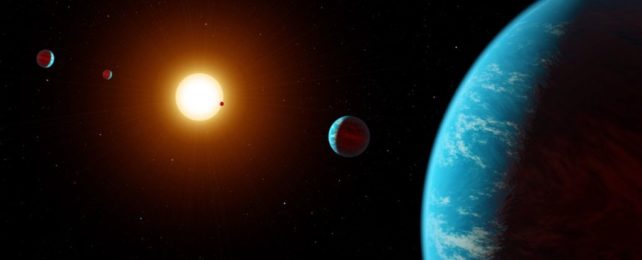Around an orange dwarf star just 130 light-years from Earth, astronomers have discovered an unexpected treasure.
Not only is the star orbited by three rocky super-Earth worlds, but two more exoplanets in the system are almost incredibly rare in our records.
These two are super-Mercuries, a type of exoplanet so difficult to spot that we've only identified eight, including the new discoveries.
All five exoplanets are too close to their host star for life as we know it to be possible, but the discovery represents the best laboratory yet for learning more about super- Mercury exoplanets – and Mercury itself, right here in the Solar System.
"For the first time we have discovered a system with two super-Mercuries," says astrophysicist Susana Barros of the Institute of Astrophysics and Space Sciences (IA) in Portugal. "This allows us to obtain clues about how these planets were formed, which could help us exclude some possibilities."
Finding exoplanets is hard, and finding small ones is even harder. Currently, astronomers rely on two main methods: the transit method and the radial velocity method.
For the transit method, astronomers will look for very faint, regular dips in the light of a star – the sign of an orbiting exoplanet passing between us and it.
The radial velocity method looks for changes in wavelengths of light reaching us from the star as it "wobbles" on the spot, tugged about by the gravitational pull of an orbiting exoplanet.
As you can imagine, both these signals – transit and radial velocity – are tiny. We're more likely to detect bigger signals created by bigger exoplanets.
NASA's exoplanet-hunting telescope TESS, which uses the transit method, first spotted two exoplanets orbiting the star HD 23472 a few years ago, and follow-up observations confirmed their presence. Two other exoplanet candidates were also detected.
Barros and her team wanted to take a closer look at the HD 23472 system because they were trying to understand the small planet radius gap: A mysterious lack of planets between 1.5 and 2 Earth radii. The two confirmed exoplanets were on the high side of this gap, and the two candidates were on the smaller side.
The difference, astronomers suspect, may be in the presence or lack of an atmosphere. This can be inferred by calculating the density of an exoplanet, if you have both transit and radial velocity data.
The transit data, which tells you how much of a star's light is blocked by an exoplanet, can give you its size. The radial velocity data, which tells you the gravitational pull exerted on a star by an exoplanet, can give you its mass. Density can be calculated using these two measurements.
So, between July 2019 and April 2021, the team set about obtaining very precise radial velocity measurements of the star using the ESPRESSO spectrograph on the European Southern Observatory's Very Large Telescope. And they found evidence of a fifth exoplanet snugged in close to the star, one with a lower mass than Earth.
Then, in October 2021, TESS picked up the transit signature of this fifth exoplanet.
The team crunched all the numbers and characterized the system. From closest to the star to farthest:
- HD 23472 d has an orbital period of 3.98 days, a radius 0.75 times that of Earth, and a mass 0.54 times that of Earth.
- HD 23472 e, the most recent discovery, has a 7.9-day period, and is 0.82 Earth radii and 0.76 Earth masses.
- HD 23472 f has a 12.16-day period, and clocks in at 1.13 Earth radii and 0.64 Earth masses.
- HD 23472 b has a 17.67-day orbital period, and is 2.01 Earth radii and 8.42 Earth masses.
- HD 23472 c has an orbital period of 29.8 days, and is 1.85 Earth masses and 3.37 Earth radii.
These measurements give densities that are comparable to Earth for the three outer exoplanets and consistent with significant atmospheres.
The two inner exoplanets, however, have high densities. This suggests that they may be similar to Mercury in composition, with a large core and a small mantle compared to other planets.
We don't know why Mercury is this way; it may be that it collided with something early in the Solar System that literally knocked a bunch of material away, or that the heat of the Sun evaporated a bunch of it.
Finding two together suggests that a one-off event like a collision might be unlikely.
"If an impact large enough to create a super-Mercury is already very unlikely, two giant impacts in the same system seems very improbable," Barros explains.
"We still don't know how these planets are formed but it appears to be connected to the composition of the parent star. This new system can help us find out."
It's unclear whether the two candidate super-Mercuries have atmospheres; we'll need a more powerful telescope to find out.
"Understanding how these two super-Mercuries have formed will require further characterization of the composition of these planets," says IA astronomer Olivier Demangeon.
"As these planets have radii smaller than the Earth, current instrumentation does not have the sensitivity to probe the composition of their surface, or the existence and composition of a potential atmosphere."
Given the number of large telescopes currently under construction, hopefully, we won't have too long to wait.
The team's research has been published in Astronomy & Astrophysics.
